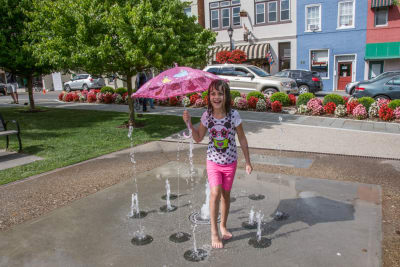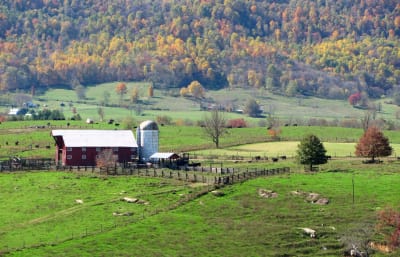-
About Our Community
-
Lewisburg (Population 3955)
The largest municipality in Greenbrier County and its county seat, Lewisburg is a picturesque 233-year old town that seems perfectly at home in the Twenty-First Century. The city encompasses a National Register Historic District with 60 buildings and homes dating from the 18th and 19th centuries. The 2011 winner of Frommer Budget Travel Magazine’s “Coolest Small Town in America”, the community is often praised for its architectural preservation, lamppost and flower-lined streets, fine restaurants and shops, and vibrant arts scene. Three performing arts venues – Carnegie Hall, Greenbrier Valley Theatre, and the Lewis Theater – offer year-round cultural events, and in any given season there’s likely to be a festival or two. For many, Lewisburg embodies small town charm.
White Sulphur Springs (Population 2463)
Home of the world famous Greenbrier, an historic 10,000-acre luxury resort, White Sulphur Springs is the second-largest municipality in the county. The first golf course in the United States, Oakhurst Links, was established near the town in 1884, and still operates as part of The Greenbrier. The Dandelion Festival is held in White Sulphur Springs on Memorial Day weekend, and the Freshwater Folk Festival takes place at the National Fish Hatchery every fall. For decades the Greenbrier was the location of a top-secret underground Congressional bunker, now declassified but open for tours. An annual PGA tour event, the Greenbrier Classic, draws thousands to the area, and the summer training camp for the NFL’s New Orleans Saints on the hotel grounds also has events open to the public.
Ronceverte (Population 1766)
Legend has it that French cartographers are responsible for Ronceverte’s musical-sounding name, which means Greenbrier in French and was formally adopted in 1882. Once both a railroad town and the site of the world’s largest softwood lumber mill, Ronceverte was Greenbrier County’s center of commerce in the late 19th and early 20th centuries. The community’s popular Island Park, on the banks of the Greenbrier River, includes a boat launch for fishermen and kayakers, an amphitheater, ball fields, a playground, and walking paths. The Ronceverte River Festival, with its popular Rubber Ducky Race, takes place every year in June. In May 2005 over 130 buildings in Ronceverte were placed on the National Register of Historic Places. The community is currently restoring its centerpiece 1915 railroad depot, with plans for an outdoor farmer’s market and indoor retail space.
Rainelle (Population 1487)
The largest community in Greenbrier County’s western end, Rainelle’s heritage is connected to timber production. The town was founded in 1905 by brothers Thomas and John Raine, who moved there to exploit one of the last large stands of virgin hardwood in the eastern United States. The area’s vast forests have been owned and managed by the Meadow Creek Lumber Company, Georgia Pacific, Westvaco, and Plum Creek Timber Company. Every fall Rainelle hosts the Meadow River Festival, a favorite with bluegrass music fans. In the spring the community celebrates the veterans riding their motorcycles through the town on their way to Washington, D.C., during their annual Run for the Wall.
Alderson (Population 1184)
A riverfront town in Greenbrier and Monroe Counties, Alderson was settled in 1777 by missionary John Alderson, who organized the first Baptist Church in the Greenbrier Valley. Incorporated in 1881, the town is known for its weeklong Fourth of July celebration, which includes a parade, canoe races, a fireman’s rodeo, concerts and a large fireworks display. The Federal Prison Camp, Alderson, a minimum-security facility for female offenders, is the community’s largest employer, with a $12 million annual payroll. Famous inmates have included Iva D’Aquino (Tokyo Rose), would-be presidential assassins Lynette “Squeaky” Fromme and Sara Jane Moore, and businesswoman Martha Stewart. Alderson’s original concrete arch bridge has been repurposed as a pedestrian footbridge, and its 1896 railroad depot has been restored and houses a railroad and local history museum.
Rupert (Population 946)
The second largest community in Greenbrier County’s western end, Rupert serves the nearby coal and timber industries. In September Rupert hosts the Rupert Country Fling, a forty-year-old tradition. Rupert’s settlement dates to the early 1800’s, when Dr. Cyrus Rupert, a physician who made his rounds on horseback to care for the people in western Greenbrier and Fayette Counties, purchased land near the mouth of Big Clear Creek. Part of his purchase became the town, which wasn’t incorporated until 1945. Artist Max Hayslette, whose landscape and wildlife paintings are represented in over 350 collections, was born in Rupert in 1929.
Quinwood (Population 291)
This small community in the northwestern part of Greenbrier County was founded in 1919 by Quin Morton and Walter Wood to exploit the Sewell coal seam. A Miners Memorial Park stands on the same site as the former coal company store. A rare book by Dennis Deitz, The Layland Mine Explosion, gives a firsthand account of vintage coal mining in the area. One of the county’s most active Emergency Ambulance squads is based in Quinwood.
Renick (Population 206)
A farming community in northern Greenbrier County, Renick’s heritage dates to its first settlement in 1769. The Greenbrier River and its tributary Spring Creek run through this part of the county, which has some of the most beautiful scenery in the region, with winding country roads, pick-your-own blueberry patches, and sheep and cattle farms.
-
Serving the Greater Greenbrier Valley since 1985—
We're here to help you!
-
Chamber Hours of Operation
Monday - Thursday
9:00am - 1:00pm
-

-
 Networking Opportunities
Networking Opportunities
The Greater Greenbrier Chamber of Commerce offers networking opportunities to showcase member's products, services, and facilities. Networking through the Chamber offers tangible marketing value for area businesses.
- Business After Hours (monthly) — hosted by a member showcasing products, services, and facilities.
- Speed Networking Luncheon (quarterly) — a direct and fun way to market your business and make important contacts.
See the Events page for more details
-
Join Today
Start benefiting from your Chamber membership, today!
-
-
Serving the Greater Greenbrier Valley since 1985—
We're here to help you!
Greater Greenbrier Chamber of Commerce
© Copyright 2024 Greater Greenbrier Chamber of Commerce. All Rights Reserved. Site provided by GrowthZone - powered by ChamberMaster software.


.JPG-w1200.jpg)















-w1900.jpg)


